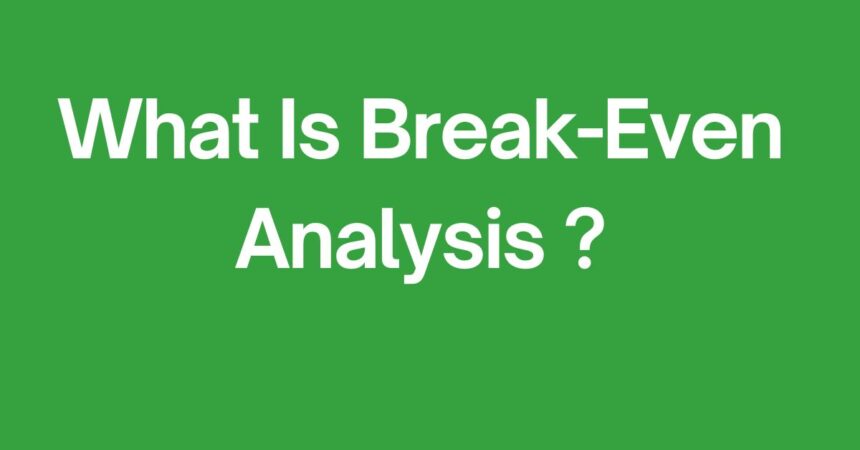Break-even analysis is a vital financial tool used by businesses to determine the point at which they will start to make a profit. It is the level of sales at which a company’s total revenues equal its total costs, resulting in neither profit nor loss. This analysis helps businesses understand how much they need to sell to cover their costs and begin generating profit.
Key Takeaways
- Break-even analysis helps businesses identify the sales volume needed to cover both fixed and variable costs.
- It is a crucial tool for pricing, cost control, and forecasting.
- Example: A business that sells widgets for $50 and has total fixed costs of $10,000 must sell 200 widgets to break even.
What Is Break-Even Analysis?
Break-even analysis is a technique that helps businesses determine the break-even point—the level of sales at which total revenues equal total costs. This point is significant because it marks the threshold at which a business starts generating a profit. The analysis involves calculating fixed costs, variable costs, and the revenue generated per unit of sale to arrive at the break-even point.
To calculate the break-even point, businesses use the following formula:
Break-even Point (Units) = Fixed Costs / (Selling Price per Unit – Variable Cost per Unit)
Where:
- Fixed Costs are the costs that do not change regardless of the level of production, such as rent, salaries, and insurance.
- Variable Costs are the costs that vary with the level of production, such as raw materials and direct labor.
- Selling Price per Unit is the price at which the product is sold.
Why is Break-Even Analysis Important?
Break-even analysis provides valuable insights into a business’s financial health and performance. Here’s why it’s important:
- Pricing Strategy: By understanding the break-even point, businesses can set their product prices to ensure they generate enough sales to cover their costs.
- Cost Control: Break-even analysis highlights the relationship between fixed and variable costs. Businesses can use this information to reduce costs and improve profitability by analyzing which costs need to be controlled.
- Sales Target Setting: The break-even point provides a clear sales target for businesses. Once the break-even point is achieved, any additional sales contribute directly to profit.
- Profitability Forecasting: Knowing the break-even point allows businesses to forecast when they will become profitable, helping in planning and investment decisions.
Example of Break-Even Analysis
Imagine a company that sells handmade leather wallets. The fixed costs associated with running the business (such as rent, salaries, and utilities) total $20,000 per year. The variable cost for each wallet (materials, labor, etc.) is $30, and each wallet is sold for $80.
To calculate the break-even point, we use the formula:
Break-even Point (Units) = $20,000 / ($80 – $30)
Break-even Point (Units) = $20,000 / $50
Break-even Point (Units) = 400 wallets
In this example, the company needs to sell 400 wallets to cover all of its costs. Any sales beyond 400 wallets will contribute to profit.
How Break-Even Analysis Can Be Used in Business
- Determining Profitability: A business can use break-even analysis to assess whether its product pricing and sales targets are sufficient to cover its costs and achieve profitability.
- Investment Decisions: Investors use break-even analysis to evaluate the risk associated with investing in a business. A company with a lower break-even point is generally seen as having a lower risk profile.
- Business Planning: New businesses often rely on break-even analysis to create realistic sales projections and budget for initial investments and operating costs.
- Cost Management: Break-even analysis can also assist in understanding how changes in fixed or variable costs affect overall profitability. For example, reducing variable costs or increasing prices can lower the number of units needed to reach the break-even point.
Break-Even Analysis vs. Contribution Margin Analysis
While both break-even analysis and contribution margin analysis are used to assess a business’s financial performance, they focus on slightly different aspects:
- Break-even analysis is used to calculate the exact point at which a business neither makes a profit nor incurs a loss.
- Contribution margin analysis looks at the contribution of each unit of product sold toward covering fixed costs and generating profit. The contribution margin is calculated by subtracting the variable cost per unit from the selling price.
For example, if a product sells for $100, and the variable cost per unit is $60, the contribution margin is $40. This helps businesses understand how much each sale contributes to covering fixed costs.
Limitations of Break-Even Analysis
While break-even analysis is an essential financial tool, it does have some limitations:
- Assumptions: Break-even analysis assumes that costs and prices remain constant, which may not always be the case in real-world business operations. Changes in costs, market conditions, or customer preferences can affect the break-even point.
- Focus on Volume: Break-even analysis focuses mainly on sales volume and may overlook other factors like market demand, competition, and marketing strategies.
- Product Complexity: Businesses with multiple products or services may find it challenging to calculate a single break-even point. Instead, a more complex break-even analysis may be required for each product line.
Break-even analysis is a fundamental tool for understanding the financial viability of a business. By calculating the point at which revenues equal costs, businesses can make more informed decisions about pricing, cost management, and profitability. While it has limitations, it remains an essential part of financial forecasting, business planning, and strategic decision-making.




